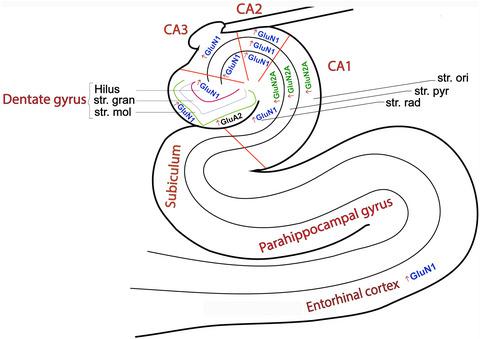当前位置:
X-MOL 学术
›
Brain Pathol.
›
论文详情
Our official English website, www.x-mol.net, welcomes your feedback! (Note: you will need to create a separate account there.)
Glutamatergic receptor expression changes in the Alzheimer's disease hippocampus and entorhinal cortex
Brain Pathology ( IF 6.4 ) Pub Date : 2021-07-16 , DOI: 10.1111/bpa.13005 Jason H Y Yeung 1 , Joshua L Walby 1 , Thulani H Palpagama 1 , Clinton Turner 2 , Henry J Waldvogel 1 , Richard L M Faull 1 , Andrea Kwakowsky 1
Brain Pathology ( IF 6.4 ) Pub Date : 2021-07-16 , DOI: 10.1111/bpa.13005 Jason H Y Yeung 1 , Joshua L Walby 1 , Thulani H Palpagama 1 , Clinton Turner 2 , Henry J Waldvogel 1 , Richard L M Faull 1 , Andrea Kwakowsky 1
Affiliation

|
Alzheimer's Disease (AD) is the leading form of dementia worldwide. Currently, the pathological mechanisms underlying AD are not well understood. Although the glutamatergic system is extensively implicated in its pathophysiology, there is a gap in knowledge regarding the expression of glutamate receptors in the AD brain. This study aimed to characterize the expression of specific glutamate receptor subunits in post-mortem human brain tissue using immunohistochemistry and confocal microscopy. Free-floating immunohistochemistry and confocal laser scanning microscopy were used to quantify the density of glutamate receptor subunits GluA2, GluN1, and GluN2A in specific cell layers of the hippocampal sub-regions, subiculum, entorhinal cortex, and superior temporal gyrus. Quantification of GluA2 expression in human post-mortem hippocampus revealed a significant increase in the stratum (str.) moleculare of the dentate gyrus (DG) in AD compared with control. Increased GluN1 receptor expression was found in the str. moleculare and hilus of the DG, str. oriens of the CA2 and CA3, str. pyramidale of the CA2, and str. radiatum of the CA1, CA2, and CA3 subregions and the entorhinal cortex. GluN2A expression was significantly increased in AD compared with control in the str. oriens, str. pyramidale, and str. radiatum of the CA1 subregion. These findings indicate that the expression of glutamatergic receptor subunits shows brain region-specific changes in AD, suggesting possible pathological receptor functioning. These results provide evidence of specific glutamatergic receptor subunit changes in the AD hippocampus and entorhinal cortex, indicating the requirement for further research to elucidate the pathophysiological mechanisms it entails, and further highlight the potential of glutamatergic receptor subunits as therapeutic targets.
中文翻译:

阿尔茨海默病海马和内嗅皮层谷氨酸受体表达变化
阿尔茨海默病 (AD) 是全球痴呆症的主要形式。目前,AD 的病理机制尚不清楚。尽管谷氨酸能系统广泛参与其病理生理学,但关于 AD 脑中谷氨酸受体表达的知识存在差距。本研究旨在使用免疫组织化学和共聚焦显微镜来表征死后人脑组织中特定谷氨酸受体亚基的表达。使用自由浮动免疫组织化学和共聚焦激光扫描显微镜来量化海马亚区、下托、内嗅皮层和颞上回特定细胞层中谷氨酸受体亚基 GluA2、GluN1 和 GluN2A 的密度。与对照相比,人类死后海马中 GluA2 表达的量化显示 AD 中齿状回 (DG) 的层 (str.) 分子显着增加。在 str 中发现增加的 GluN1 受体表达。DG,str的分子和门。CA2 和 CA3 的东方,海峡。CA2 的锥体和 str。CA1、CA2 和 CA3 亚区和内嗅皮层的辐射。与 str 中的对照相比,AD 中的 GluN2A 表达显着增加。东方海峡 金字塔形和海峡。CA1亚区的辐射。这些发现表明,谷氨酸能受体亚基的表达在 AD 中显示出大脑区域特异性变化,这表明可能存在病理性受体功能。
更新日期:2021-07-16
中文翻译:

阿尔茨海默病海马和内嗅皮层谷氨酸受体表达变化
阿尔茨海默病 (AD) 是全球痴呆症的主要形式。目前,AD 的病理机制尚不清楚。尽管谷氨酸能系统广泛参与其病理生理学,但关于 AD 脑中谷氨酸受体表达的知识存在差距。本研究旨在使用免疫组织化学和共聚焦显微镜来表征死后人脑组织中特定谷氨酸受体亚基的表达。使用自由浮动免疫组织化学和共聚焦激光扫描显微镜来量化海马亚区、下托、内嗅皮层和颞上回特定细胞层中谷氨酸受体亚基 GluA2、GluN1 和 GluN2A 的密度。与对照相比,人类死后海马中 GluA2 表达的量化显示 AD 中齿状回 (DG) 的层 (str.) 分子显着增加。在 str 中发现增加的 GluN1 受体表达。DG,str的分子和门。CA2 和 CA3 的东方,海峡。CA2 的锥体和 str。CA1、CA2 和 CA3 亚区和内嗅皮层的辐射。与 str 中的对照相比,AD 中的 GluN2A 表达显着增加。东方海峡 金字塔形和海峡。CA1亚区的辐射。这些发现表明,谷氨酸能受体亚基的表达在 AD 中显示出大脑区域特异性变化,这表明可能存在病理性受体功能。



























 京公网安备 11010802027423号
京公网安备 11010802027423号